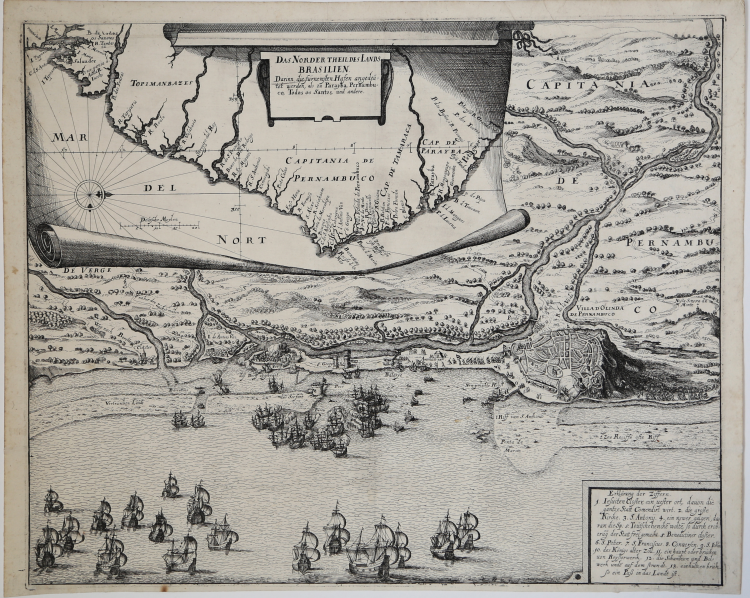




| Reference: | MMS2888 |
| Author | Matthaus MERIAN "il vecchio" |
| Year: | 1633 ca. |
| Zone: | Pernambuco |
| Printed: | Frankfurt |
| Measures: | 450 x 370 mm |



| Reference: | MMS2888 |
| Author | Matthaus MERIAN "il vecchio" |
| Year: | 1633 ca. |
| Zone: | Pernambuco |
| Printed: | Frankfurt |
| Measures: | 450 x 370 mm |
The map, displayed on a roll above, shows the coastal contours, with place-names along the Brazilian coast near Recife and Olinda, and below is a bird's-eye view of the siege with ships and the movements of the troops.
With the hope of taking control of the sugar trade in Brazil, the fleet of the Dutch West India Company attacked Recife. While the troops landed further north, the fleet, under the command of Admiral Lonq, tried to force an entrance to the harbour but his ships were repulsed by the Portuguese, under the command of Albuquerque.
The siege lasted two weeks and in the end the Dutch finally broke through. The Portuguese, however, not wishing their rivals to benefit from their labours, burnt all their sugar warehouses and shipping, the loss of which was estimated at two million ducats.
Matthaus MERIAN "il vecchio" (Basilea 1593 - Bad Schwalbach 1650)
|
Known for his mature work as a topographical printmaker based in Germany, Matthaeus Merian spent half a dozen of his early years in Lorraine and Paris (1610-15). He had learned to etch in Basel by 1609, the date on an etching copied from an old view of that city, and had studied etching and glass painting in Zurich in 1610. He was taken to Nancy as the assistant to etcher Friedrich Brentel. In 1610-11 they produced the series of large etchings that documented the funeral of Duke Charles III of Lorraine. In Nancy, Merian came into contact with Jacques Bellange, some of whose etchings he was to copy a few years later. Merian continued on to Paris where he worked productively from 1612-15. He learned by copying works by such French engravers as the portraitists Leonard Gaultier and Thomas de Leu, and the architect Claude Chastillon. He etched portraits of Louis XIII, Marie de Medici, and Anne of Austria, often with views of Paris in the background. He recorded out-of-doors court festivals and royal ceremonies, and public buildings such as the Hotel de Ville. He returned to Basel in 1616, during which time he completed a few plates, for a total of some fifty prints of French subjects.
The artist's total oeuvre is enormous, consisting of nearly 700 single plates and series of prints, plus thousands of additional vignettes, views, and book illustrations. His experience in France was important for him and important for the documentation of French life. Few French-born etchers were active at this time, and Merian's timely and observant images are among the liveliest journalistic records of that era.
In Frankfurt he spent most of his working life and with Martin Zeiller(1589-1661), a German Geographer, and later with his own son, he produced a series of Topographia consisting of 21 volumes including a very large number of town plans as well as maps of most countries and a World Map, a very popular work issued in many editions. He also took over and completed the later parts and editions of the Grand Voyages and Petits Voyages originally started by De Bry in 1590.
|
Matthaus MERIAN "il vecchio" (Basilea 1593 - Bad Schwalbach 1650)
|
Known for his mature work as a topographical printmaker based in Germany, Matthaeus Merian spent half a dozen of his early years in Lorraine and Paris (1610-15). He had learned to etch in Basel by 1609, the date on an etching copied from an old view of that city, and had studied etching and glass painting in Zurich in 1610. He was taken to Nancy as the assistant to etcher Friedrich Brentel. In 1610-11 they produced the series of large etchings that documented the funeral of Duke Charles III of Lorraine. In Nancy, Merian came into contact with Jacques Bellange, some of whose etchings he was to copy a few years later. Merian continued on to Paris where he worked productively from 1612-15. He learned by copying works by such French engravers as the portraitists Leonard Gaultier and Thomas de Leu, and the architect Claude Chastillon. He etched portraits of Louis XIII, Marie de Medici, and Anne of Austria, often with views of Paris in the background. He recorded out-of-doors court festivals and royal ceremonies, and public buildings such as the Hotel de Ville. He returned to Basel in 1616, during which time he completed a few plates, for a total of some fifty prints of French subjects.
The artist's total oeuvre is enormous, consisting of nearly 700 single plates and series of prints, plus thousands of additional vignettes, views, and book illustrations. His experience in France was important for him and important for the documentation of French life. Few French-born etchers were active at this time, and Merian's timely and observant images are among the liveliest journalistic records of that era.
In Frankfurt he spent most of his working life and with Martin Zeiller(1589-1661), a German Geographer, and later with his own son, he produced a series of Topographia consisting of 21 volumes including a very large number of town plans as well as maps of most countries and a World Map, a very popular work issued in many editions. He also took over and completed the later parts and editions of the Grand Voyages and Petits Voyages originally started by De Bry in 1590.
|